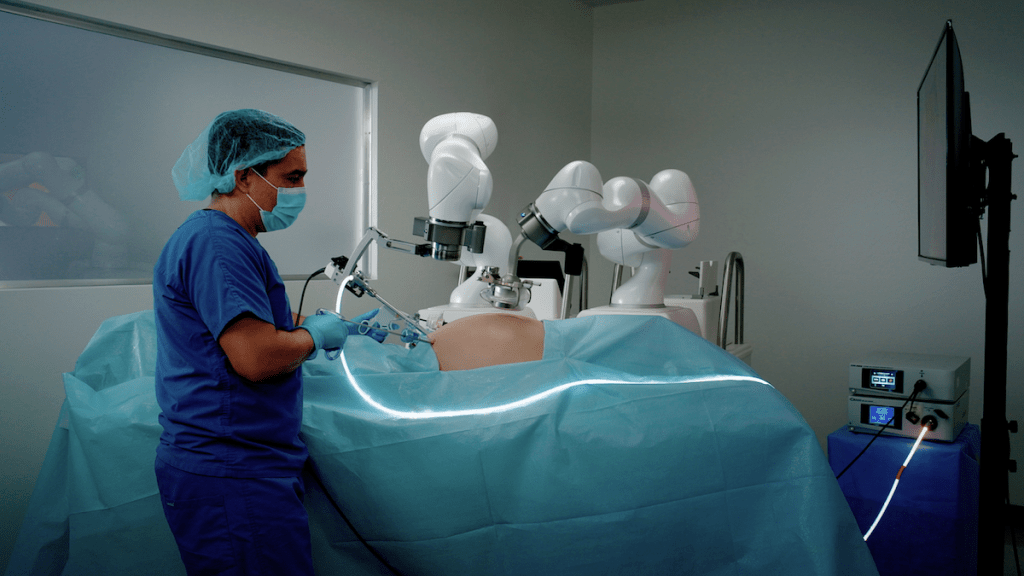MARS is empowering surgeons with enhanced control, reducing patient recovery times, and streamlining hospital operations through innovative magnetic technology.
Dr. Alberto Rodriguez-Navarro is advancing minimally invasive surgery with his innovative technology, the MARS Surgical System.
“Our purpose as a company is to develop technology to empower the surgeon. That’s why we see our latest development, MARS Surgical System, making surgery better.”
Dr. Rodriguez-Navarro is a surgeon and the CEO, Founder, and President of Levita® Magnetics, a medical equipment manufacturing company established in 2011. For the past 13 years, he and his team have developed proprietary technology that maximizes the benefit of minimally invasive surgery—for both surgeons and patients.
“We started with a manual system [magnetic surgery], in which you have to move the magnet with your hand. Now, we’ve evolved to create a robotic system that controls the movement of the magnet.”
What does this mean for surgeons?
The MARS System, which leverages Levita Magnetics’ proprietary Dynamic Magnetic Positioning technology, builds on the clinical benefits of the Levita Magnetic Surgical System providing faster recovery, less pain, and fewer scars for patients. But now, the team has developed surgeon-controlled arms allowing full control over the laparoscopic view and the magnetic retractor.
The MARS system gives surgeons “two extra arms” for instrument control, as well as camera stability, removing the need for additional assistance, which standard abdominal surgeries require.
“MARS represents a noteworthy advancement and is part of the pathway to enhance minimally invasive surgery for healthcare institutions, surgeons, and most importantly, for patients. It’s also remarkably easy to use,” said Prof Dr. Matthew Kroh, MD, vice chair of innovation and technology at the Cleveland Clinic, who performed the first procedure with the new system last September 2023.
“We aim to show that this revolutionary technology can empower surgeons with increased control and better visualization while reducing the number of incisions, delivering significant patient benefits,” says Dr. Rodriguez-Navarro.
For Dr. Rodriguez-Navarro, who worked for nearly ten years as a surgeon and performed over 3,000 laparoscopic surgeries, this is a major feat in the advancement of minimally invasive surgeries.
Levita is headquartered in Silicon Valley, and the MARS System is FDA-approved and currently available in the U.S. and Chile. It is cleared for laparoscopic bariatric surgeries, cholecystectomy (gallbladder), prostate, and colorectal procedures.
“We invented a system to deploy a magnetic piece inside the abdomen, and then using a powerful external magnet, we generate the movement to reduce the number of incisions typically needed for the surgery,” Dr. Rodriguez-Navarro explains. “That’s the core benefit—we reduce the number of incisions for the patient. Meanwhile, the surgeon maintains the ability to perform the procedure in a fast and reliable way.”
While it may be easier for surgeons to continue performing standard procedures, learning and integrating this new system has a “triple impact” for patients, surgeons, and hospitals—and aids in providing more efficient, economical care.
The current state of the U.S. healthcare system is dire—a very circulated topic—and Duquesne University forecasts a shortage of more than 29,400 nurse practitioners by 2025. Dr. Rodriguez-Navarro’s system removes the need for an additional assistant during procedures and cuts recovery time for patients. The MARS System is easy to use, as Prof Dr. Matthew Kroh noted above, and can also “play a major role in the transition of high volume abdominal procedures to an ambulatory or same-day discharge setting,” says Dr. Rodriguez-Navarro.
In 2018, there were 9.6 million inpatient operating room procedures of which 11.2% were MIS and 2.9% were robotic-assisted. Cholecystectomy (gallbladder removal) surgery is one of the most common procedures performed worldwide, and Dr. Rodriguez-Navarro positions Levita Magnetics as an economical medical innovation to lessen the demand on the current healthcare system.
“That’s the opportunity that we see. We can bring a solution that is a fraction of the cost of other robotic leaders in surgery, plus the clinical benefit and the reduction of personnel, to make the procedure more cost-effective. That’s our opportunity in the market,” he says.
In April, Dr. Rodriguez-Navarro performed the first-ever augmented reality abdominal surgery in Santiago, Chile using the MARS System and Meta Quest 3 headset. “It opens a new world for how the surgeon can access [data] in real-time during the surgery,” he told Fox News Digital. “It will be a revolution in how surgeries are performed, and I’m very happy [about] how technology is empowering surgeons to do more.”
While the early stages of Dr. Rodriguez-Navarro’s ideations faced criticism and doubt, he understood that initial resistance is normal for any new technology, and today he and his team have proven the effectiveness and revolutionary capabilities of magnetic surgery.
“Our goal as a company is to continue to develop tools for surgeons to have better surgical outcomes,” Dr. Rodriguez-Navarro concludes. “Robots, AI, and magnets will be utilized heavily in surgical procedures in the coming years.”
To learn more about Levita Magnetics, visit the website here. To get in touch with Dr. Alberto Rodriguez-Navarro, reach out to him on LinkedIn.
VentureBeat newsroom and editorial staff were not involved in the creation of this content.

